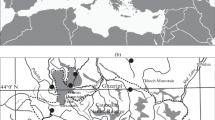Abstract
Central Chile extends under a mediterranean type of climatic influence between the 30th and 38th grades of southern latitude. Due to a great concentration of population and the agricultural activity this part of the national territory practically is lacking in natural vegetation in the interiors valleys and coastal sectors of the precordillera.
Therefore, a descriptive analisis of the vegetation is more realistic if we do it in the Andes and in the coast ranges, following the criteria of altitudinal zonalization.
The northern sector of the region shows in its vegetation levels a certain similarity in its composition and physionomy with the natural formations of lowlands and plain regions which belong basically to latitudinal grou** typical of the region.
However, south of the 33 latitude, this similarity begins to disappear mainly due to high humidity registered in the mountains. The sclerophytal woods are replaced by mixted formations where the predominant species are the Fagaceae, Lauraceae and conifer.
Between the 37 and 38 grades of southern latitude, in both mountains ranges an almost pure formation of Araucaria araucana woods, an endemic conifer of South America is developed. In the coastal range, this formation reachs its optimun ecology between 800 and 1300 meters aproximately while in the Andes this one is achieved only at 1.600 meters of altitude.
The altitudinal descent of both ranges is almost parallely with the latitudinal development to the south and this is one of the reasons why some trees have a wide distribution in some attitudinal levels. (Nothofagus obliqua, Nothofagus alpina, Nothofagus dombeyi).
It is worth noting that at present, the anthropologycal action and the reforestation with foreign species are seriously affecting the preservation of the natural woods on this mountain ranges.
Access this chapter
Tax calculation will be finalised at checkout
Purchases are for personal use only
Preview
Unable to display preview. Download preview PDF.
Similar content being viewed by others
Bibliographie
Antonioletti, R., J. Borcosque, H. Schneider & E. Zàrate. 1971. Características climâticas del Norte Chico (26° a 33° lat. S). Inst. Inv. de Rec. Nat. Santiago.
Aravena, P. 1976. Los robles-Nothofagus de la Séptima Region de Chile, Region del Maule. Rev. Maule, Univ. Cat. de Chile, N° 3: 3–8.
di Castri, F. 1968. Esquisse écologique du Chili. Biologie de l’Amérique Australe; Editions C.N.R.S., vol. IV:, Paris.
di Castri, F. & Hajek, E. 1976. Bioclimatología de Chile. Vicerrec Acad. Univ. Cat. de Chile, Santiago.
Fuenzalida, V.H. 1965. Biogeografia de Chile. Geografía Económica de Chile. Texto Ref.: 228–267. Santiago.
Garaventa, A. 1936. Por qué componentes vegetales estarían constituidos los climax en la provincia de Aconcagua. Corn. au IX Congres. Cient.: 54–64, Santiago.
Hajek, E., M. Pacheco & A. Passalacqua 1972. Anàlisis bioclimàtico de la sequía en la zona de tendencia mediterranea de Chile. Pub. N° 45 Inst. Geogr. Univ. Cat. de Chile, Santiago.
Hajek, E. F. di Castri 1975. Bioclimatografía de Chile. Dir. Invest. Univ. Cat. de Chile, Santiago.
Huber, A. 1977. Aporte a la climatologia y climaecologìa de Chile I: Radiation potential. Rev. Medio Ambiente,2(2): 22–34. Valdivia.
Hueck, K. 1966. Die Wälder Südamerikas. Stuttgart G. Fisher.
Klapp, E. 1956. Futterbau und Futterwirtschaft in Chile zwischen dem 30° und 42° S. Bonner Geograph. Abh. 17: 87–136.
Lauer, W. 1952. Humide und aride Jahreszeiten in Afrika und Südamerika und ihre Beziehungen zu den Vegetationsgürteln. Bonner Geograph. Abh. 9: 1–98.
Looser, G. 1929. Diferencias entre la vegetation de la cordillera de la Costa y la cordillera de los Andes en Chile Central. Rev. Univ. de Chile Mo XIV, Santiago.
Liiboutry, L. 1956. Nieves y glaciares de Chile. Ed. Univ. de Chile.
Mann, G. 1960. Regiones biogeogrâficas de Chile. Rev. Inv. Zool. chilenas 6: 15–49, Santiago.
Munoz, C. & E. Pisano 1947. Estudio de la vegetation y flora de los Parques nationales de Fray Jorge y Talinay. Agri. Téc. Ano VII N° 2: 71–199, Santiago.
Munoz, C. 1966. Sinopsis de la Flora chilena. Ed. Universidad de Chile, Santiago.
Oberdorfer, E. 1960. Pflanzensoziologische Studien in Chile ein Vergleich mit Europa. Flora et vegetatio mundi, Band II. J. Cramer Weinheim.
Ozenda, P. 1960–61. La détermination de la zone montagneuse à l’aide des limites altitudinales de végétation. Bull. de la Fed. française d’Eco. Montagnarde; N° 11, 4: 50–57.
Pisano, E. 1956. Esquema de clasificación de las comunidades vegetales de Chile. Agronomie II, N° 1, Santiago.
Pisano, E. 1966. Zonas biogeogrâficas de Chile. Geogr. Econom. de Chile, Primer Apend.: 62–72, Santiago.
Quintanilla, V. 1974. Les formations végétales du Chili Tempéré. Essai écologique et phytogéographique. Doc. de Cartograph. Ecolog.: 38–80, vol. XIV. Grenoble.
Quintanilla, V. 1974. La Carta bioclimâtica de Chile Central. Rev. Geogr. Valparaíso N° 5: 33–58, Valparaíso.
Quintanilla, V. 1977. A contribution to the phytogeographical study of temperate Chile. Biogeographica 8: 31–41, The Hague.
Quintanilla, V. 1977. Diccionario de Biogeografía para América Latina. Ed. Universitarias de Valparaíso, 250 p. Chile.
Quintanilla, V. 1978. Los perfiles fitogeogrâficos del medio seminàrido de Chile (Norte Chico). Rev. Geogr. Inst. Panam. Hist. y Geogr. N° 88 (sous presse).
Reiche, C. 1934. Geografia Botanica de Chile. 2 vols. Trad. de G. Looser. Imprenta Universitaria, Santiago.
Schmithüsen, J. 1954. Waldgesellschaften des Nördlichen Mittelchile. Vegetatio vol. V-VI: 479–486, The Hague.
Schmithüsen, J. 1956. Die raümliche Ordnung des chilenischen Vegetation. Bonner Geogr. Abh. 17: 1–89, Bonn.
Schneider, H. 1968. El clima del Norte Chico. Depto. de Geogr. Univ. de Chile, Santiago.
Schulmeyer, D. 1978. Observaciones fitogeogrâficas sobre la Cordillera de Nahuelbuta. Bol. Informativo. II trimest., Inst. Geogr. Militar, Santiago.
Villagràn, C. 1969. Notas palinológicas de los bosques relictuales de la zona Central de Chile. Notic Mens. Museo Hist. Nat. N° 153: 3–6, Santiago.
Author information
Authors and Affiliations
Editor information
Rights and permissions
Copyright information
© 1979 Dr. W. Junk Publishers, The Hague
About this chapter
Cite this chapter
Quintanilla, V.G. (1979). L’etagement Altitudinal de la Vegetation au Chili Central: Les Profils Phytogeographiques. In: Schmithüsen, J. (eds) Landscape Ecology/Landschaftsforschung und Ökologie. Biogeographica, vol 16. Springer, Dordrecht. https://doi.org/10.1007/978-94-009-9619-9_5
Download citation
DOI: https://doi.org/10.1007/978-94-009-9619-9_5
Publisher Name: Springer, Dordrecht
Print ISBN: 978-94-009-9621-2
Online ISBN: 978-94-009-9619-9
eBook Packages: Springer Book Archive




